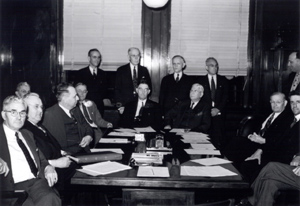
United Methodist Publishing House
The first Methodist publishing efforts began as the Methodist Book Concern in Philadelphia in 1789 with a loan of $600. Its publications were delivered by traveling preachers known as circuit riders. The Concern later relocated to New York City and opened a second office in Cincinnati.
In 1844 sectional divisions over slavery split the Methodist Episcopal Church into the Methodist Episcopal Church, North, and the Methodist Episcopal Church, South. Southern Methodists wanted their own religious publishing house and took their battle all the way to the Supreme Court to obtain the right to publish their own religious literature. Atlanta, New Orleans, St. Louis, Louisville, and Memphis all vied to be chosen as the location of the new publishing house. Nashville was selected on May 18, 1854, at a general conference of the Methodist Episcopal Church, South, held at Columbus, Georgia. The Nashville City Council was jubilant and declared that the property should never be taxed, although the denomination voluntarily chose to pay taxes on all its secular businesses. The Tennessee General Assembly granted a charter to the institution on February 26, 1856.
With money raised by subscription, Southern Methodists converted an old riverfront sugar drainery and warehouse that fronted on the Public Square. The operation contained facilities for printing on six presses; binding; composing, drying, and pressing sheets; folding; mailing; and sales. A bookstore opened in December 1854, and book manufacturing began the following February.
The Nashville operation was the first major publishing house in the South and was well received. John Early became the first book agent and provided skilled leadership in guiding the new concern. New publications produced by the southern operation were the Ladies Companion, the Sunday School Visitor, and the Quarterly Review. The Southern Methodist Publishing House also followed the lead of its northern competitor and published books in German and Spanish. Circuit riders continued to pack their saddlebags or new buggies with books, pamphlets, and magazines, and bookstores or depositories were set up.
Both northern and southern publishing houses continued operations even after the Civil War began. When the City of Nashville surrendered to federal troops in February 1862, the Union forces commandeered the Southern Methodist Publishing House for government printing. Part of the building was used as a stables and a harness shop for the remainder of the war. By the end of the war, the plant was in shambles. Southern Methodists retooled and began to publish again. Thirty years later, the United States Congress reimbursed the publishing house $288,000 for wartime damages.
Like other southern institutions, the church felt the financial stress of the postwar reconstruction. The Southern Book Concern could barely pay its employees and issued promissory scrip instead of money. Retired book agent John B. McFerrin was recalled when bankruptcy threatened to end church publishing. He traveled throughout the South selling Publishing House bonds to keep the Concern operating.
In 1872 fire destroyed the Southern House. The Methodists acquired additional land and with subscriptions from Nashvillians, financed a grand new building at 346 Public Square. The building rose seven stories from the riverside and four from the east side of the square.
A new concern with education in the South and with self-improvement nationally created new markets for the Southern House’s publications. A summer training opportunity for Methodist adults in Chautauqua Lake, New York, inaugurated a form of adult education that came to be known as “Chautauqua.” The movement used correspondence courses and circuit speakers to provide scientific, literary, and historical information as well as religious education. These educational and self-improvement movements helped foster a new era of cooperation between the Methodist Episcopal Church, North, and the Methodist Episcopal Church, South, and between their publishing concerns as the turn of the century approached.
In 1906 the Southern Methodist Publishing House moved all operations to new facilities at 810 Broadway. The concern built a new printing facility at 815 Demonbreun Street in Nashville in 1924. The Methodist denominations jointly produced two hymnals during the early part of the century. In 1939 the Methodist Episcopal Church, North, the Methodist Episcopal Church, South, and Methodist Protestant Church reunited, and Nashville was chosen as the site for a consolidated publishing facility–the Methodist Publishing House. In 1957 the House moved to 201 Eighth Avenue South. A merger with the United Brethren Church in 1968 created The United Methodist Church.



